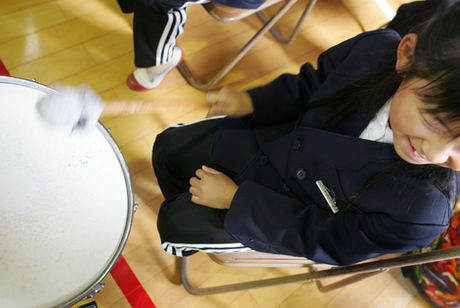Drum Circle for educational field
Drum circle in the field of education

drum circle
for Educational Field
Drum circle in the field of education
Drum Circles and Education
Drumming in school creates opportunities for collaboration among students, fulfillment of academic curricular standards, and healthier social connections in the school community.
Cooperative group drumming is clinically proven to reduce stress, improve dexterity, and stimulate our immune systems. Drumming together also increases positive social connections among all the players. In situations where students participate in drumming together routinely, teachers often notice improved attendance on ‘drum days,’ and many students say drumming helps them enjoy their time at school more. Rhythmic musical activities are the easiest form of music-making to participate in. Students can begin playing as soon as you invite them to, no knowledge of notes or chords is necessary. It’s also FUN. Kids love to drum, the activities are 100% participatory, and Village Music Circles facilitators make it enjoyable to play together. This can be especially rewarding for students learning a new language, students with physical or mental challenges, or students with Attention Deficit Hyperactivity Disorder (ADHD).
Village Music Circles facilitators can provide drumming activities for students of all ages, all levels of ability, and for groups of all sizes. Unique events enable different age groups to develop different skills. VMC facilitators can drum with a group as small as 3 or 4 students, or an entire classroom, or with assemblies of several hundred students simultaneously. Drumming with a class of 20 kindergarten students may help them practice listening to other players, following verbal and non verbal cues, playing together, taking turns, and large muscle control. A drumming event with 200 students in grade seven may emphasize constructive interactions with peers, appreciation of diversity, and leadership training. Community drum circles with students, parents, siblings, and school faculty drumming together can create positive experiences for the entire school community to share.
Facilitated drumming events can also fulfill academic curricular standards. Many teachers use rhymes, chants, or raps in their classrooms to help students’ retention of math facts, or let the students’ appreciation of drumming guide projects in geography, history, sociology, physics, and other sciences. Many teachers appreciate cooperative group drumming because it helps the students develop positive social and emotional skills with their peers. VMC facilitator training is available for teachers interested in learning to facilitate interactive rhythm events.
For VMC facilitators, some of our favorite moments are the times we empower a student to lead the group. To see the look on his/her face as they stand in front of all their peers, nearly overwhelmed by all the attention, then feel the affect of their signals as the group responds, and fulfill the role of leadership as they facilitate. Not only do those moments result in thundering applause, they are nothing less than the seeds of success and self confidence, and the memory of it may stay with that student for years to come, even a lifetime. Drumming together is fun for each individual, provides opportunities for lifelong learning, and strengthens social connections among the students in the school community.
Cameron Tummel, M.F.A.





